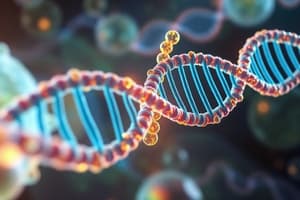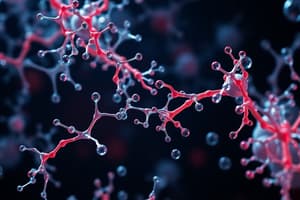Podcast
Questions and Answers
What is the function of ribosomes?
What is the function of ribosomes?
- To synthesize fats
- To synthesize carbohydrates
- To synthesize proteins (correct)
- To synthesize nucleic acids
What is the characteristic of the nucleus in eukaryotes?
What is the characteristic of the nucleus in eukaryotes?
- It is found in prokaryotes
- It is absent in eukaryotes
- It houses the cell's genetic material (correct)
- It is found outside the cell
What is the function of the cell wall in prokaryotes?
What is the function of the cell wall in prokaryotes?
- To provide extra layer of protection, maintain cell's shape, and prevent dehydration (correct)
- To synthesize proteins
- To replicate DNA
- To provide movement to the cell
What is the primary function of flagella in prokaryotes?
What is the primary function of flagella in prokaryotes?
What is the characteristic of circular chromosome in prokaryotes?
What is the characteristic of circular chromosome in prokaryotes?
What is the primary function of pili in prokaryotes?
What is the primary function of pili in prokaryotes?
What is the characteristic of protists?
What is the characteristic of protists?
What is the primary function of sexual reproduction in protists?
What is the primary function of sexual reproduction in protists?
Which field of biology is concerned with the study of genes, genetic variations, and principles of heredity?
Which field of biology is concerned with the study of genes, genetic variations, and principles of heredity?
What is the field of biology that deals with the application of the laws of physics to biological occurrences?
What is the field of biology that deals with the application of the laws of physics to biological occurrences?
Which field of biology involves the study of the behavior and interactions of life forms and marine creatures with the ocean?
Which field of biology involves the study of the behavior and interactions of life forms and marine creatures with the ocean?
What is the field of biology that studies the molecular structure of biological macromolecules?
What is the field of biology that studies the molecular structure of biological macromolecules?
Which field of biology involves the study of the interactions of living organisms with light?
Which field of biology involves the study of the interactions of living organisms with light?
What is the field of biology that deals with the study of the action of ionizing radiation on living beings and their health effects?
What is the field of biology that deals with the study of the action of ionizing radiation on living beings and their health effects?
Which field of biology involves the biology of the nervous system?
Which field of biology involves the biology of the nervous system?
What is the field of biology that uses fossils to study life's history?
What is the field of biology that uses fossils to study life's history?
What is the primary function of carbohydrates in the body?
What is the primary function of carbohydrates in the body?
What type of bonds link monosaccharides together in polysaccharides?
What type of bonds link monosaccharides together in polysaccharides?
What is the main difference between amylose and amylopectin?
What is the main difference between amylose and amylopectin?
What is the function of glycogen in the body?
What is the function of glycogen in the body?
What is the main component of plant cell walls?
What is the main component of plant cell walls?
What percentage of Leptospirosis patients experience a systemic form of the disease?
What percentage of Leptospirosis patients experience a systemic form of the disease?
What is the characteristic of dietary fibers?
What is the characteristic of dietary fibers?
What is the primary mode of transmission of Leptospira interorgan?
What is the primary mode of transmission of Leptospira interorgan?
What is the function of proteins in the body?
What is the function of proteins in the body?
What is the causative agent of Syphilis?
What is the causative agent of Syphilis?
What is the characteristic of starches?
What is the characteristic of starches?
What is the primary symptom of Gonorrhea in women?
What is the primary symptom of Gonorrhea in women?
Why are antibiotics ineffective against viruses?
Why are antibiotics ineffective against viruses?
What is the structural component of a virus that surrounds the nucleocapsid and is used for attachment to host cells?
What is the structural component of a virus that surrounds the nucleocapsid and is used for attachment to host cells?
What is the first step in the viral replication process?
What is the first step in the viral replication process?
What is the shape of some viral particles?
What is the shape of some viral particles?
Which of the following is NOT a component of a nucleotide?
Which of the following is NOT a component of a nucleotide?
What is the main difference between DNA and RNA in terms of their sugar molecules?
What is the main difference between DNA and RNA in terms of their sugar molecules?
Which of the following is a pyrimidine found in DNA but not in RNA?
Which of the following is a pyrimidine found in DNA but not in RNA?
What type of bond connects the nucleotides in a nucleic acid chain?
What type of bond connects the nucleotides in a nucleic acid chain?
Which of the following is the correct base pairing rule in DNA?
Which of the following is the correct base pairing rule in DNA?
Which type of RNA carries the genetic information from DNA to the ribosome for protein synthesis?
Which type of RNA carries the genetic information from DNA to the ribosome for protein synthesis?
Which of the following is NOT a function of nucleic acids?
Which of the following is NOT a function of nucleic acids?
Myoglobin is a protein found in high concentrations in which type of tissue?
Myoglobin is a protein found in high concentrations in which type of tissue?
Which of the following statements about myoglobin is TRUE?
Which of the following statements about myoglobin is TRUE?
What is the primary function of DNA in a cell?
What is the primary function of DNA in a cell?
Flashcards are hidden until you start studying
Study Notes
Cell Biology
- Studies the structure and function of cells
Branches of Biology
- Genetics: study of genes, genetic variations, and principles of heredity
- Ecology: study of the interaction of living organisms with one another and physical environment
- Evolution: study of heritable changes and diversification over multiple generations
- Biochemistry: intersection of biology and chemistry, studies various chemical and physicochemical processes
- Biophysics: deals with the application of the laws of physics to biological occurrences
- Molecular Biology: deals with the structure of proteins and nucleic acids and their functions
- Structural Biology: studies the molecular structure of biological macromolecules
- Biotechnology: exploitation of biological processes for the production of hormones, antibodies
- Immunology: concerned with immunity
- Marine Biology: study of the behavior and interactions of life forms and marine creatures with the ocean
- Photobiology: study of the interactions of living organisms with light
- Radiobiology: study of the action of ionizing radiation on living beings and their health effects
- Neurobiology: studies the biology of the nervous system
- Paleontology: uses fossils to study life’s history
- Forensic Science: application of science to answer questions related to the law
Biology Pioneers
- Ribosomes: molecular machines that synthesize proteins
Prokaryotes
- Simple, single-celled organism
- Lacks a nucleus and membrane-bound organelles
- Nucleoid: central region of the cell
- Circular Chromosome: single large loop
- Cell Wall: provides extra layer of protection, maintains cell shape, and prevents dehydration
- Capsule: outermost layer, sticky, and helps the cell to attach to surfaces
- Flagella: whip-like structures, act as rotary motors to help bacteria move
- Fimbriae: numerous, hair-like structures, used for attachment to host cells and surfaces
- Pili: allow transfer DNA to other bacteria and involved in bacterial locomotion
- Size: 0.1 to 5.0 micrometer
Eukaryotes
- Packed with a fascinating array of subcellular structures that play important roles in energy balance, metabolism, and gene expression
- Nucleus: houses the cell’s genetic material
- Organelles: specialized functions that float in the cytosol
- Multiple Linear Chromosomes
Kingdom Protista
- Protists: simple eukaryotic organisms, neither plants nor animals or fungi
- Unicellular in nature but can also be found as a colony of cells
- Live in water, damp terrestrial environments, or as parasites
- Have cilia or flagella for mobility
- Sexual Reproduction: cell fusion and zygote formation
Groups of Kingdom Protista
- Chrysophytes: golden algae and diatoms, found in marine and freshwater
- Dinoflagellates: photosynthetic and marine, dependent on key pigments in their cells
- Euglenoids: live in motionless freshwater, cell wall is absent but has a protein-rich layer called pellicle
- Leptospirosis: spread from animals to humans (zoonosis), symptoms include flu-like illness, causes Leptospira interogran, and treatment involves penicillin or doxycycline
Viruses
- Type of germ, can make you sick
- Antibiotics don’t work on them
- Composed of nucleic acid and the genome is surrounded by protein capsid, which is usually subdivided into capsomeres
- Have an envelope surrounding the nucleocapsid, and it, with the spikes, are used for attachment to host cells
- Helical, icosahedral, and complex symmetry
Viral Replication and Control
- Attachment: virus becomes attached to a target epithelial cell
- Penetration: cell engulfs the virus by endocytosis
- Uncoating: viral contents are released
- Biosynthesis: viral RNA enters the nucleus, replicated by the viral RNA polymerase
- Assembly: new phage particles are assembled
Polysaccharides
- Sugar polymers containing more than 20 or so monosaccharide units
- Most abundant carbohydrate in food
- Long chain of monosaccharides linked by glycosidic bonds
- Homopolysaccharides and heteropolysaccharides
Starches
- Stored form of sugars in plants
- Made up of a mixture of amylose and amylopectin
- Important sources of calories found in foods
- Sugar molecules that human intestinal enzyme can break down
- Not sweet
Amylose
- Starch formed by unbranched chains of glucose monomers
- Poorly soluble in water and slowly digestible
Amylopectin
- Branched polysaccharide
- More soluble in water and more easily digestible than amylose
Dietary Fibers
- Carbohydrate that intestinal enzymes cannot break down; non-digestible
- Have molecules that are resistant to human enzymes
- Critical, slows down the absorption of simple sugar
- Helps blood glucose level
Glycogen
- Storage form of glucose in humans and vertebrates
- Made up of monomers of glucose
- Animal equivalent of starch and is a highly branched molecule usually stored in liver and muscle cells
- Glycogenolysis: whenever blood glucose levels decrease, glycogen is broken down to release glucose
Cellulose
- Most abundant natural biopolymer
- Cell wall of plants is mostly made of this; wood and paper are mostly cellulosic in nature
Functions of Carbohydrates in the Body
- Provides body with energy
- Cells convert carbohydrates into fuels molecule ATP through a process called cellular respiration
- Provides stored energy
- Promotes good digestive health by reducing constipation and lowering the risk of digestive tract diseases
Proteins
- Polymers of amino acids; function as catalysts
- Most versatile macromolecules in living systems and serve crucial functions in essentially all biological processes
- Transport and store other molecules such as oxygen
- Provide mechanical support and immune protection
- Generate movement, transmit nerve impulse, and control growth and differentiation
- Contain a wide range of functional groups
- Can interact with one another and with other biological macromolecules to form complex assemblies
- Some are quite rigid, whereas others display limited flexibility
Studying That Suits You
Use AI to generate personalized quizzes and flashcards to suit your learning preferences.




